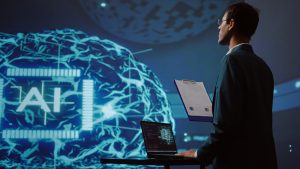Why is employee training crucial for a company?
Employee Training represents a strategic investment that can bring many benefits to the company benefits. In the digital age, where technology, remote work and business processes are changing, adaptability is becoming a key competitive advantage. Employees equipped with the right knowledge and skills are more effective, motivated and loyal, improving the performance of the entire organization. Studies also show improved talent retention – companies with structured training programs retain up to 69% of their employees longer than those without them.
Smart Arena offers an advanced e-learning and LMS platform that enables automated individual learning paths, flexible educational plans and a wide library of over 400 e-courses in the Slovenian language. With analytics and training performance measurement tools, it helps companies demonstrate impact and optimize programs in real time.
Legal framework and employers' obligations
Employers are obliged to provide training to employees in accordance with the Employment Relations Act (ZDR-1). The law clearly states that the employer must provide training for employees, especially when it comes to occupational health and safety. In addition, companies often have additional internal policies, standards (e.g. ISO) and documentation that further define the method and scope of implementation.
Needs analysis and training plan
Before starting training, it is crucial to conduct a thorough needs analysis:
- Surveys and interviews that are conducted with company employees and managers.
- Competency models, which define the required knowledge for individual roles.
- Definition of KPIs – it is necessary to define what actually measures the success of training.
Based on this, a plan is later created with clear objectives, content, deadlines and resource allocation.

Training methods – comparison
Internal training
Internal training is delivered by experienced staff or mentors within the company, which allows for adaptation to the specific needs and culture of the organization. This makes the content relevant and directly applicable, and employees feel that they are being invested in their personal development. The disadvantage is that the quality of leadership can vary greatly if mentors are not properly trained or if they lack the time to prepare and deliver the modules.
External training
External training – such as workshops, seminars and certified courses – offer a high level of expertise and a structured approach. They are carried out by specialized institutions, which gives the company access to the latest content and external experts. The main disadvantage is the higher costs, both financial and organizational, as employees often have to be absent from work. Nevertheless, it is considered an excellent solution when looking for external certifications or top-notch experience.
Microlearning
Microlearning focuses on short, targeted modules, which usually last 5–15 minutes. Such a format promotes higher engagement (up to 50 % more) and better knowledge retention, as students can focus on a single competency, after which data shows that they achieve up to 60 % higher content retention. Another advantage is the rapid production of content – up to three times faster and cheaper than with traditional courses. Microlearning is flexible, allows access to content where and when it is needed, and can be easily integrated into existing LMS environment.
E-learning in LMS
E-learning supported by LMS (Learning Management System), brings high flexibility and easy content distribution. Employees can study at their own pace, and the LMS enables automated tracking, assessment, and analytics. Digital access reduces transportation and printed material costs, while ensuring an equal experience for all participants – regardless of location. Up-to-date content is also a great advantage, as modules can be updated on a regular basis, which maintains the relevance and quality of training.
you blended learning
Blended learning is a combination of online and traditional learning formats, combining the advantages of both – theory from e-classrooms and practical live implementation (workshops, simulations). The advantages include saving time and costs, greater learning efficiency and better engagement. Participants can learn independently, and then upgrade and consolidate their knowledge in interaction with mentors and colleagues. LMS allows for progress monitoring and adaptation of content to individuals, which contributes to personalization and better results.
Measuring training effectiveness
The Kirkpatrick model is most commonly used to monitor performance:
- Reaction – how satisfied are the participants? (surveys by module)
- Learning – what did they actually learn? (tests, assessments)
- Behavior – is the knowledge used at work? (observations, interviews)
- Results – does the training bring business benefits? (KPI, savings)
This approach allows for a deeper understanding of the effects of training and provides a basis for improvements.

Benefits of training for employees and the company
Benefits for employees
- improved professional knowledge and soft skills,
- motivation, confidence and a sense of worth,
- a clearly defined path of development and advancement.
Benefits for the company
- greater productivity and standardization of processes,
- lower costs, fewer errors and greater innovation,
- improved retention of experts and reduced turnover.
Examples of good practices
The organization has introduced one of the newest approaches – micro-modules to train employees on how to implement new software. Short, targeted modules lasting only 5-10 minutes allow employees to focus on actually using the tools as soon as they need them. This method has helped to speed up the adoption of changes and increase the automation of key processes. Employee satisfaction has increased significantly after the introduction of this design, as they report greater confidence in their work and a sense of support, which is also reflected in fewer errors and faster resolution of everyday problems.
In hybrid environments where both traditional and online training are combined, LMS (Learning Management System) adds value. With clear procedures and an intuitive interface, onboarding new employees has become faster and more efficient. Newcomers receive structured learning content, unlimited repetition, and immediate feedback through quizzes and tests. Managers can monitor the progress and use of individual modules and adjust support in a timely manner. This combination of micro-modules and LMS significantly facilitates the implementation process, shortens the time to full productivity, and strengthens the sense of connection with the team – even remotely.
How to successfully implement training
- Needs analysis – basic phase.
- Goal setting – measurable and realistic.
- Method selection – according to the types of knowledge and available resources.
- Pilot implementation – test on a smaller sample.
- Evaluation; Kirkpatrick – response, learning, behavior, results.
- Expansion and repetition – continuous optimization and adaptation.
It is also important that management and HR are actively involved and that effective communication is organized before and during implementation.
Frequently Asked Questions (FAQ)
- What is the difference between training and education?
Training is practical and goal-oriented (e.g. mastery of tools), while education is more general (e.g. broader knowledge of the field). - How often should training be conducted?
Depending on job requirements, it is recommended to evaluate employees annually and conduct refresher courses 1–2 times a year. - Which methods are the most cost-effective?
E-learning and microlearning through an LMS are affordable and scalable, especially for large organizations.
take a strategic step in the right direction
Employee training is not just a legal requirement – it is a strategic element that builds an innovative, adaptable and motivated work environment. With proper analysis, implementation, measurement and adaptation, a company can achieve clearly measurable benefits.
👉 Book demo and discover how ready-made e-courses, artificial intelligence for content creation, and advanced analytics can raise your team's competency and satisfaction levels overnight.





